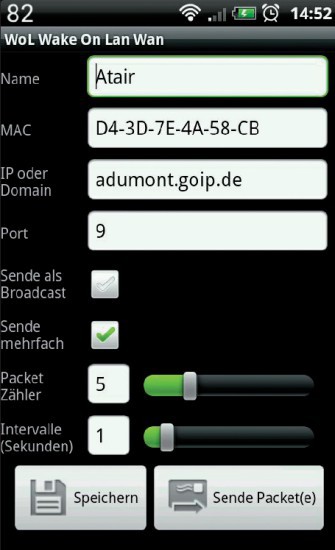
Usually this is port 9, less frequently 7. Generally, a UDP packet is used, and is generally sent to a specific UDP port. So it can be sent by TCP, UDP, or may others.

A magic packet may be contained in any of the numerous formats of packets on the net, as all the NI looks for is the bit format.
#WOL PACKET SENDER MAC#
Magic packets have to be sent to a MAC address, not an IP address. The NIC is to recognize the synchronization bytes of FF, and its own MAC six times as the "go now" signal. This packet contains six bytes of FF (decimal 255) one after the other, followed immediately by sixteen repetitions of the MAC for the NIC. Magic Packet = specially formed packet sent to the NI to make it pull the "wake me now" line. MAC addresses are used as a network address for most IEEE 802 network technologies, including Ethernet." (copied from wikipedia) The MAC is a factory-burned-in hardware address that the NI recognizes as "that's me". MAC = "A media access control address (MAC address) is a unique identifier assigned to network interfaces for communications on the physical network segment. NIC = Network Interface Card as above, but plugs into a slot on the motherboard somehow. It's job is to receive the magic packet and pull the "wake me up now" line on the motherboard. NI = Network Interface typically a chip set intended to receive ethernet, but can be optical fiber or some other versions of networking. This is what many people want to do, but risky and even more of a fancy dance step than WOL Also called WOWLAN, WOWAN, other variants of the acronym. WOW = Wake on Wide Area Net, which is WOL but sent from the wild, wooly internet. WOL = Wake On LAN, what we're trying to do.
#WOL PACKET SENDER SOFTWARE#
The problem is, WOL needs eveything from the functions of the machine sending the WOL message to the entirety of the receiving machine to be working perfectly, and "perfectly" has a very long, very picky definition that is hardware and software dependent.įirst some definitions, because I use acronyms a lot. The data you lose may be your own, and it won't be the fault of FreeNAS. Think carefully about whether you know the things you don't know in enough detail. I fully accept that the data I lose is my own, and I will not blame FreeNAS for my fumbles. I have a long history with computers, back into the 70s, and have the scars to prove it.


Worse, because of your lack of education, you may do this without even knowing the dangers. This is probably dead accurate - if you do lots of shut down and wake cycles on your FreeNAS machine, and are not really skilled at what needs done and not done, you flirt with total loss of your data by your own actions and ignorance. It's intended to be run 24/7 and optimized for doing that.I have been warned that indiscriminate shutdown and wake up endangers your data in myriad ways. FreeNAS is not intended to be woken and shut down on demand.


 0 kommentar(er)
0 kommentar(er)
